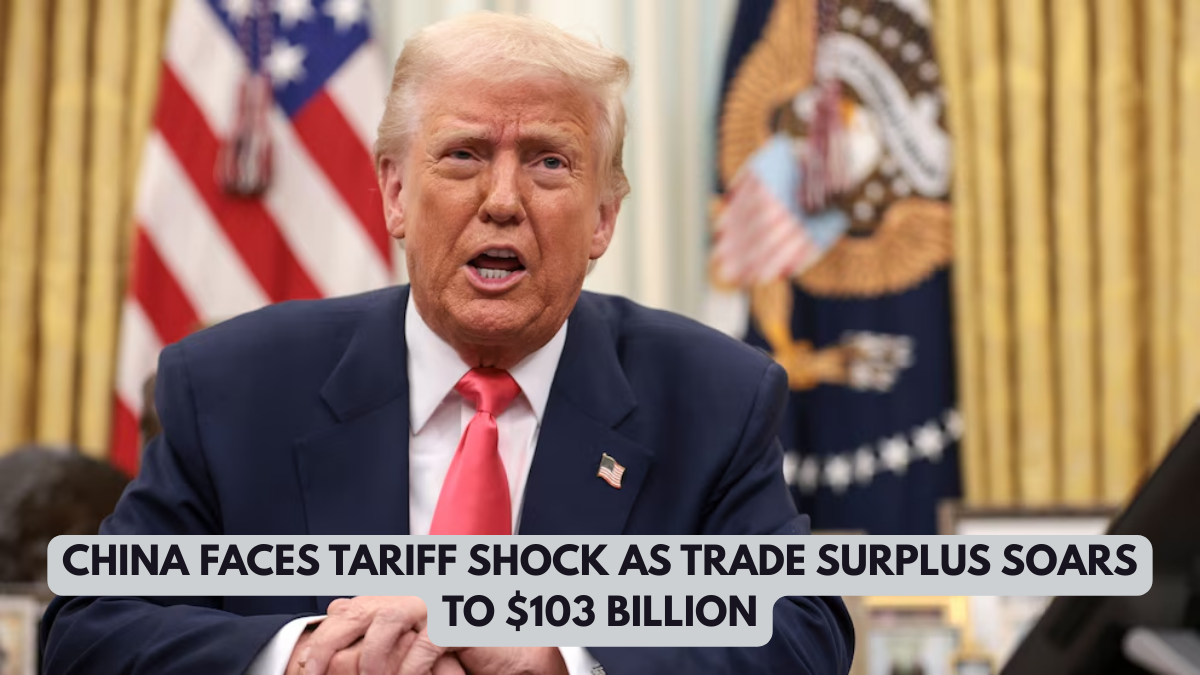China’s global trade dynamics are facing a significant shift, as the country records a staggering trade surplus of $103 billion, sending shockwaves through global markets and intensifying the ongoing trade tensions with the United States. The new data, marking a sharp increase in China’s trade surplus, has raised alarm among international trade experts, with the U.S. gearing up for a potential tariff escalation in response to China’s growing economic dominance. Here’s an in-depth look at the trade surplus, the implications for China and the global economy, and the impending tariff shocks that could reshape global trade relations.
Record-Breaking Trade Surplus
According to the latest data from the General Administration of Customs of China, the country’s trade surplus for the first quarter of 2025 reached a historic $103 billion, fueled by a surge in exports and relatively subdued imports. This surplus, which marks a sharp increase compared to previous years, underscores China’s robust manufacturing capabilities, particularly in the export of high-tech goods, including electric vehicles, industrial robots, and 3D printers. China’s export volume in the first quarter of 2025 alone amounted to $1.4 trillion, reflecting the continued demand for Chinese-made goods despite global economic uncertainty (aa.com.tr).
While China’s exports saw significant growth, imports remained relatively stable at $1.3 trillion, leading to the burgeoning trade surplus. This imbalance has become a focal point in the U.S.-China trade war, which has intensified since 2018 with escalating tariffs between the two global economic giants. With China’s trade surplus growing, questions have arisen about the long-term impact on global supply chains and the economic future of both China and its trading partners.
Tariff Escalations on the Horizon

In response to China’s growing trade surplus, U.S. lawmakers are preparing to impose even more stringent tariffs on Chinese imports. The U.S. has already imposed tariffs of up to 125% on many Chinese goods, a move aimed at curbing the trade imbalance and forcing China to address concerns over unfair trade practices. Additionally, China has retaliated by levying tariffs of up to 84% on U.S. exports, especially targeting agricultural products, aerospace equipment, and electronics.
The possibility of further tariff escalations remains high, particularly as the U.S. seeks to address issues related to intellectual property theft and forced technology transfers. These concerns have led to the formation of a trade strategy by the Biden administration, which could involve more aggressive measures in the coming months to force China into concessions. These retaliatory tariffs could disrupt the global flow of goods and services, causing ripple effects across industries (nypost.com).
Impact on Global Supply Chains
The escalating trade tensions are already having a significant impact on global supply chains, which were already under stress due to the COVID-19 pandemic and ongoing geopolitical instability. Chinese exporters are feeling the strain of a “frozen” U.S. market, with many American buyers delaying purchases or looking for alternative suppliers in other parts of the world. This shift has led to reduced participation by U.S. buyers at major trade fairs, including China’s largest trade expo in Canton, where Chinese exporters report a decrease in business interest from the U.S. and European markets.
As trade tensions mount, Chinese manufacturers are increasingly looking toward emerging markets to offset the loss of demand from traditional Western buyers. Countries like Nigeria, India, and Southeast Asian nations have become crucial trading partners as they seek to diversify their import sources and reduce reliance on the U.S. and European markets (reuters.com).
This shift in trade focus, however, may not be enough to counterbalance the potential long-term economic repercussions of further tariff escalations. China’s economic growth has long been driven by its export sector, and any significant disruption to this flow could lead to reduced growth forecasts and even job losses in key manufacturing industries.
China’s Dependency on Global Markets
Despite its vast domestic market, China remains heavily dependent on global consumer demand, especially from the U.S. and European Union. Analysts argue that China’s trade surplus underscores this reliance, highlighting the vulnerability of its economic model, which is heavily reliant on exports. As trade tensions increase, China’s policymakers may be forced to consider reforms to stimulate domestic consumption and reduce the country’s dependence on external markets.
However, stimulating domestic demand in China has proven challenging. The country’s aging population, coupled with slowing wage growth and rising living costs, has made it difficult for China to transition from an export-driven economy to a consumption-based one. Without significant reforms in social welfare and public services, this shift may remain out of reach, leaving China at the mercy of global market fluctuations (theguardian.com).
The Road Ahead for Global Trade

As the U.S.-China trade war intensifies, the global economy faces an uncertain future. Further tariff increases could lead to a deeper fragmentation of international trade, with countries being forced to choose sides between the two largest economies in the world. This could exacerbate the challenges facing global supply chains and lead to higher costs for consumers worldwide.
At the same time, China’s growing trade surplus may encourage other countries to adopt more protectionist measures, fearing that they too will fall victim to China’s economic dominance. The future of global trade will likely be shaped by how China, the U.S., and other key players navigate these tensions in the coming months and years.
For more information on China’s trade policies and official trade data, visit the General Administration of Customs of China and the U.S. Trade Representative.


